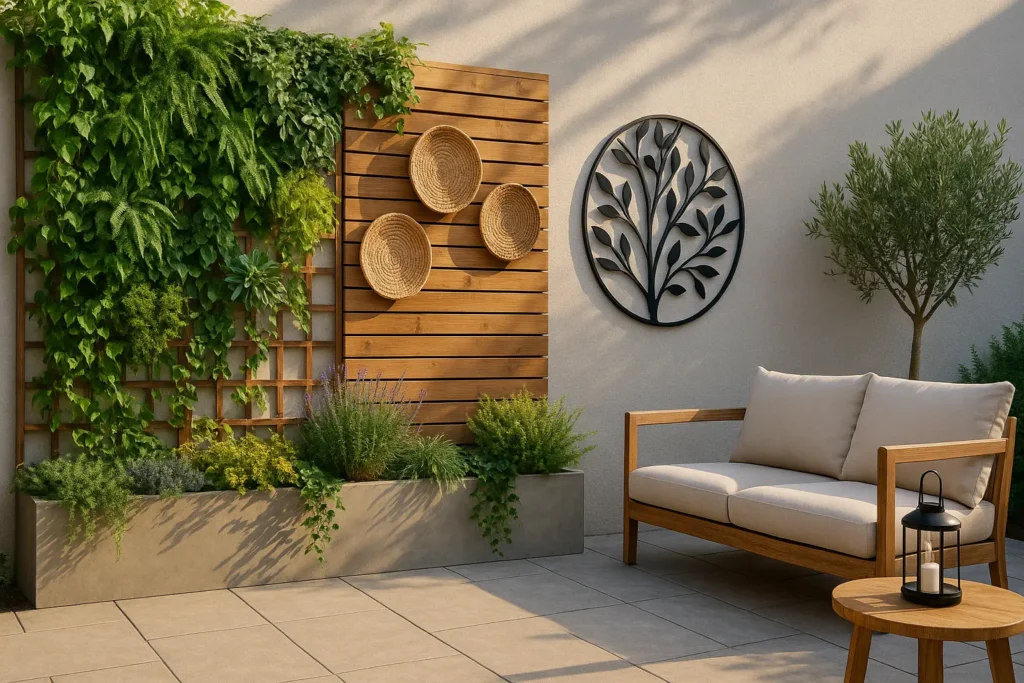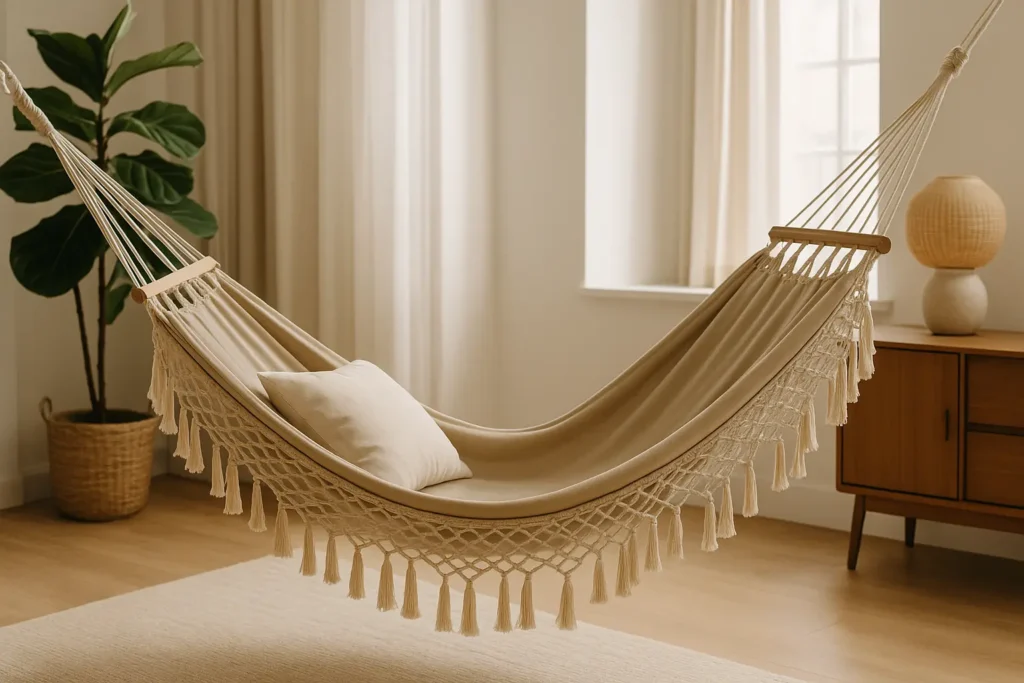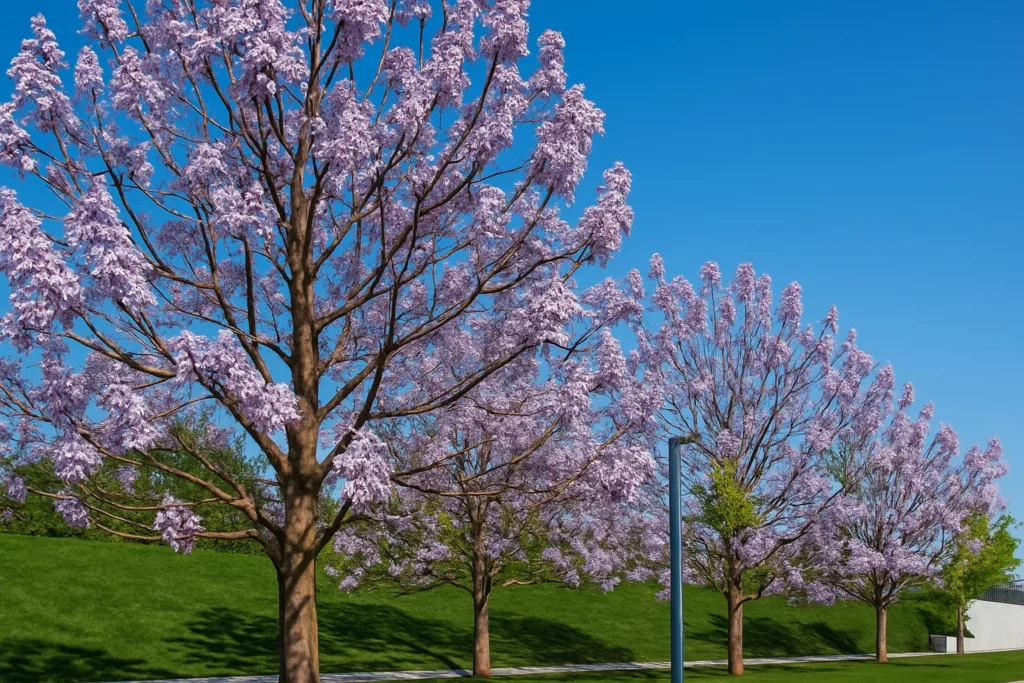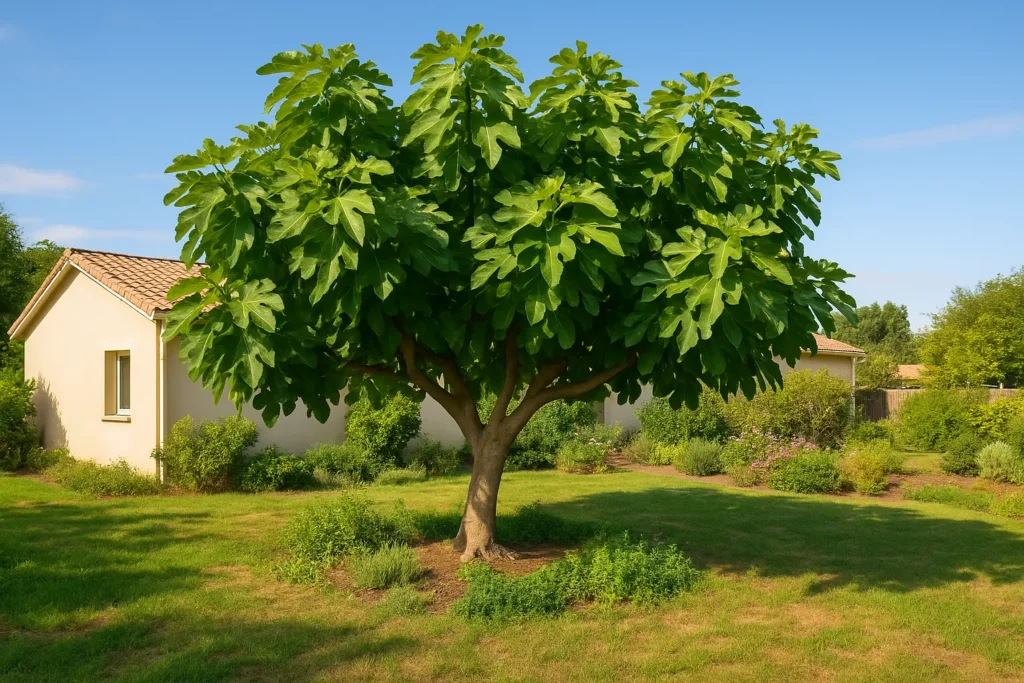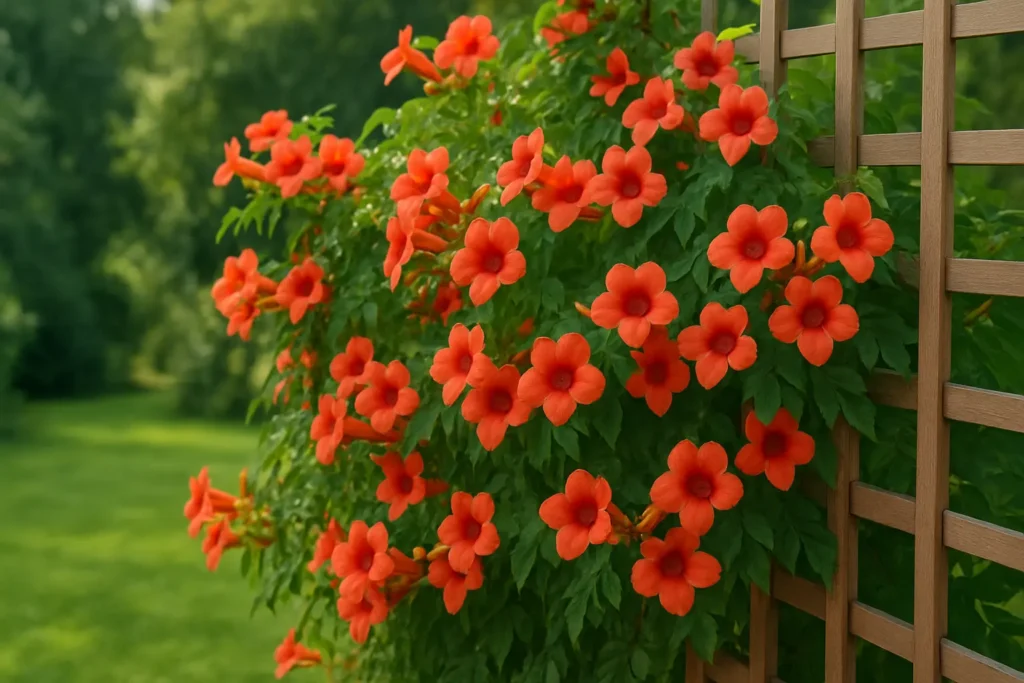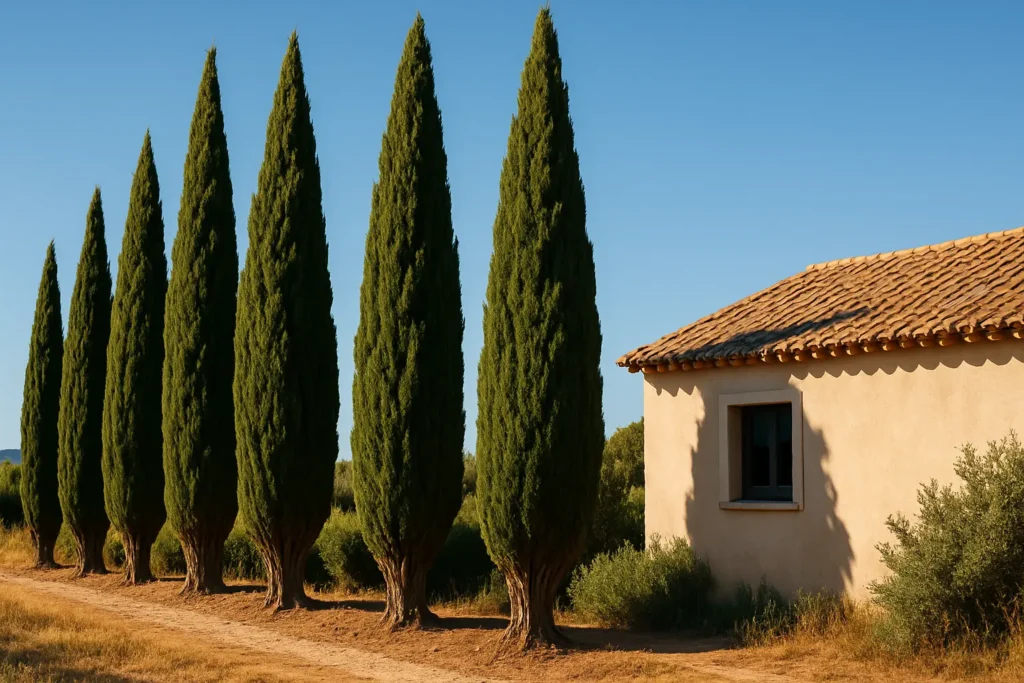The exterior layout in front of the house, It's much more than just an aesthetic issue. It's a welcoming area, a true calling card of our habitat. In this sense, it deserves our full attention. By enhancing the exterior layout in front of the house, we create a memorable first impression that reflects our personality. Whether you have a large yard or a small space, the possibilities are endless to transform your entryway into a space that is both functional and inspiring. Here are some creative ideas to help you design a exterior design that will enhance the access to your homeCombining practicality and aesthetics, these suggestions adapt to all styles, budgets and configurations.
Our article in brief:
The exterior design in front of a house is above all the first impression of your house and deserves special attention.
- A exterior landscaping in front of a house, if well-groomed, reflects your personality and can increase real estate value up to 20%.
- From natural gravel to elegant paving stones, each covering defines the ambiance of your entrance.
- Don't forget the vegetation! Plants soften the architecture and bring life and movement to the reception area.
- Well-thought-out lighting and a smooth flow of traffic transform the entrance into a space that is both practical and welcoming.
In this article
Why take care of the exterior landscaping in front of your house?
The exterior entrance is the first impression visitors will have of your home. A careful and harmonious layout of this space immediately reflects your attention to detail and your sense of hospitality. Beyond the aesthetic aspect, aexterior landscaping in front of the house Successful completion significantly increases the real estate value of your property. This can be as much as 20% according to some experts.
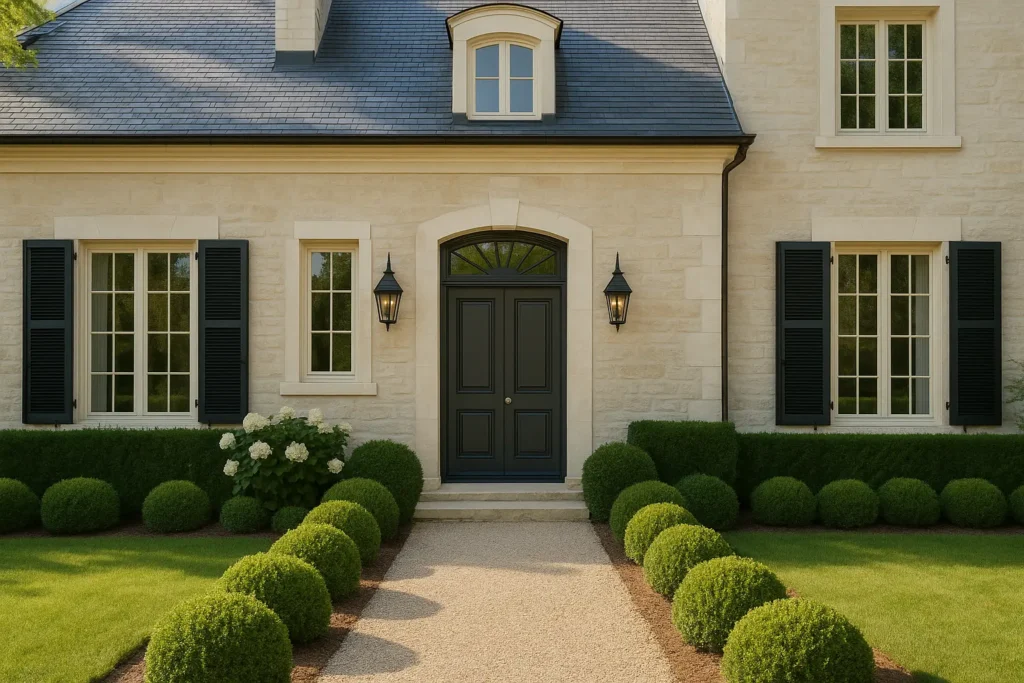
This transition zone between public space and the privacy of the home naturally structures the movement of people. A well-designed entrance intuitively guides visitors to the door, while creating visual consistency with the architecture of your home. It thus becomes a reflection of your identity and your values, even before you cross the threshold.
The essential coverings to enhance the exterior entrance of your home
The choice of flooring defines the ambiance and character of your exterior entrance. Gravel is a timeless and natural option, perfect for walkways leading to the house. Their characteristic crispness announces the arrival of visitors, and their authentic appearance blends harmoniously into almost any style of design.
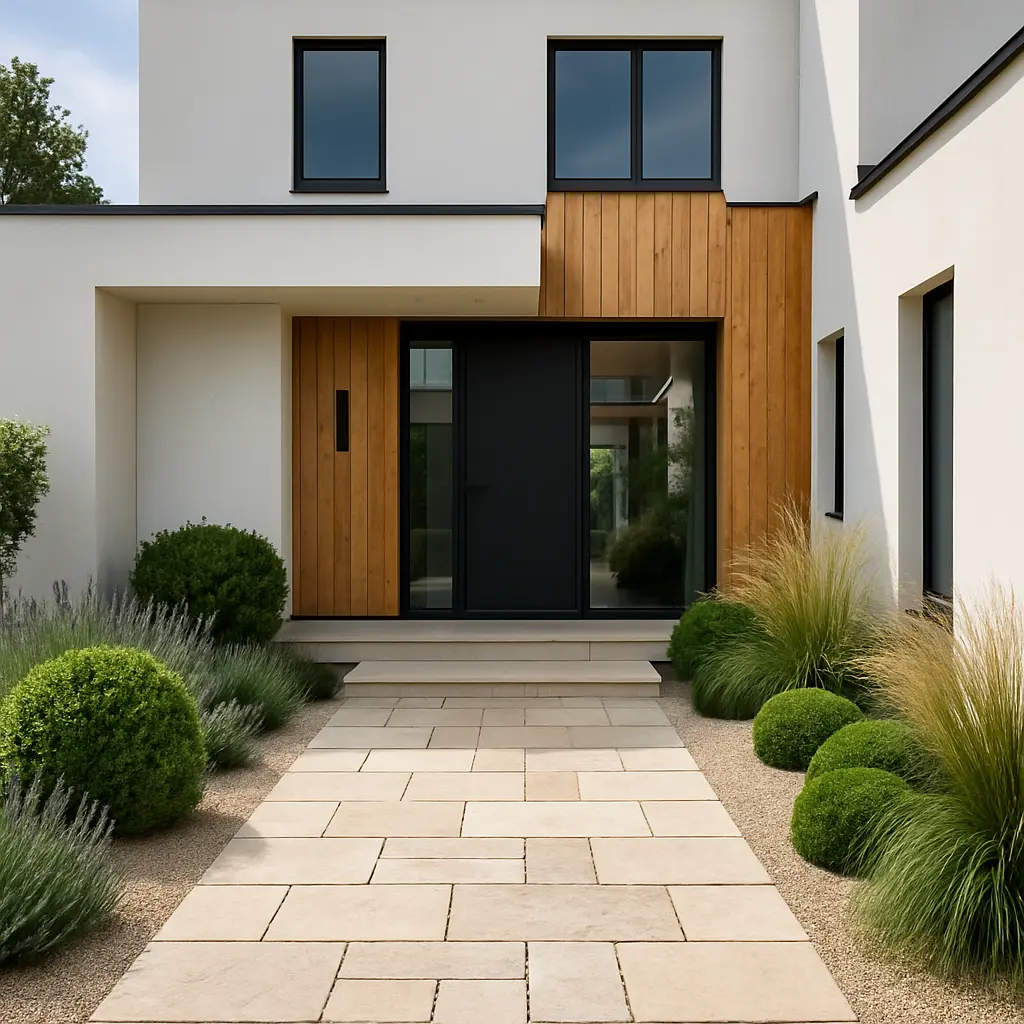
For a more structured entrance, natural stone or concrete pavers offer durability and elegance. These modular elements allow you to create varied patterns that instantly personalize the space in front of your door. If you're looking for a modern touch, the deactivated concrete reveals its aggregates for a unique, non-slip texture.
Lovers of authenticity will appreciate the natural stone slabs that bring character and nobility to the entrance. For a more contemporary approach, Composite wood combines the warm aesthetics of wood with exceptional strength to bad weather. Also consider drainage solutions such as porous asphalt, which facilitates the infiltration of rainwater while providing a uniform surface.
| Type of coating | Benefits | Exterior design style in front of house |
|---|---|---|
| Gravel | Natural, economical, draining | Countryside, rustic, Mediterranean |
| Cobblestones | Durable, modular, aesthetic | Traditional, classic, elegant |
| Composite wood | Warm, durable, contemporary | Modern, Scandinavian, natural |
| Natural stone | Noble, timeless, unique | Classic, Mediterranean, luxurious |
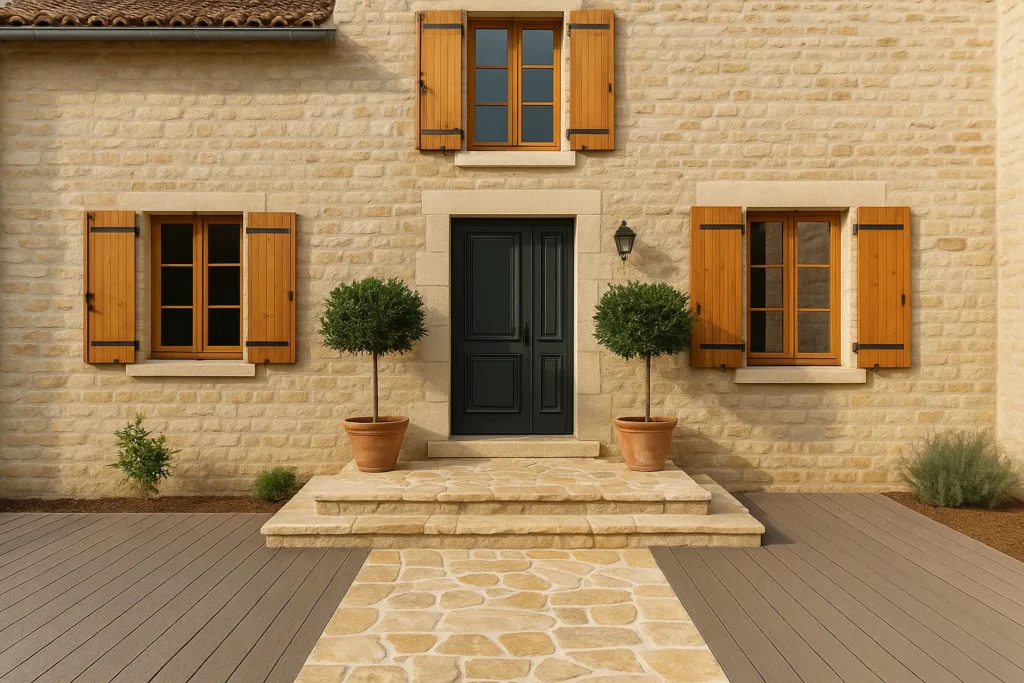
Create an outdoor layout in front of a house with plants and vegetation
Vegetation softens architectural lines and brings life and movement to your exterior entrance. Climbing plants such as wisteria or clematis create an enchanting setting around the porch or front door. Be careful, however, with overly invasive species such as the bignonia which has certain disadvantages if it is not regularly pruned.
To structure the space, nothing beats low hedges or plant borders. These elements naturally guide people towards the entrance while providing a permanent touch of greenery. Flowering shrubs like hydrangeas or roses add color and fragrance, while ornamental grasses provide graphics and movement even on windy days.
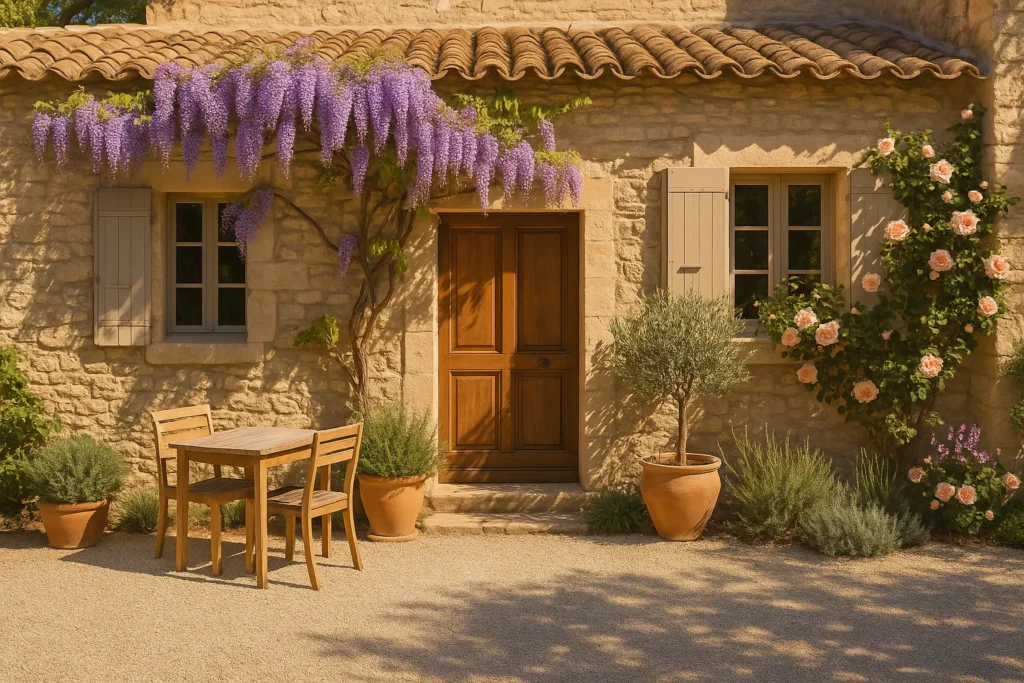
Plants adapted to each exposure
The exposure of your entrance determines the plants to favor. In the north, opt for shade-loving plants like hostas or ferns. In the south, lavender or santolina will withstand the heat perfectly. However, avoid Paulownia tomentosa whose defects and disadvantages include an invasive root system, not very compatible with a restricted entry space.
Consider staggering your blooms to keep your driveway attractive all year round. Spring bulbs followed by summer perennials and then autumn grasses create a captivating plant succession. which will evolve over the seasons.
How to create a functional and practical exterior entrance?
Beauty is not enough.exterior landscaping in front of your house must also be practical. Well-designed lighting secures access while highlighting the layout. Combine wall lights to illuminate the facade, markers along the driveway and recessed spotlights to highlight architectural elements.
Plan a sheltered area to protect you from the elements, such as a porch or a canopy over the door. These functional elements often become focal points that characterize the facade. Don't forget to install a sturdy doormat to keep the interior clean.
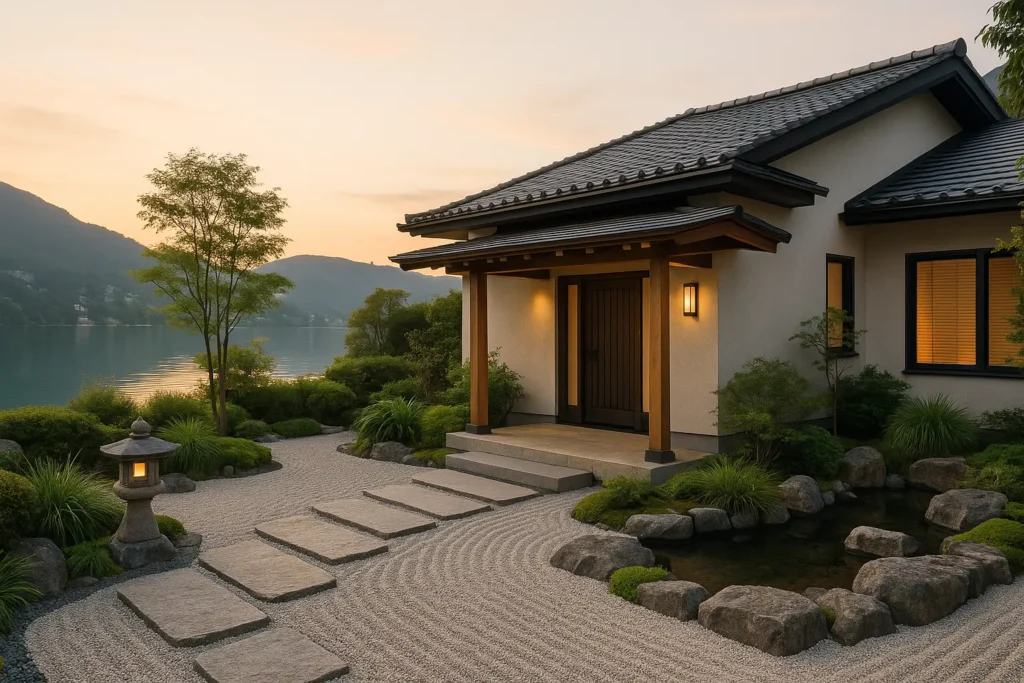
Traffic should remain fluid between the street and your house. If you have a yard, organize the space to facilitate vehicle maneuvers. A sufficiently wide and clearly defined aisle naturally guides visitors to the main entrance, avoiding any confusion.
Also consider incorporating rainwater management solutions, such as discreet gutters or draining surfaces, which are particularly important to prevent water from accumulating near the door.
The different styles of exterior design in front of a house
- Country style : beige gravel, old rose bushes, clematis, wrought iron furniture and terracotta pottery for an authentic and romantic atmosphere
- Contemporary style : clean lines, XXL concrete slabs, graphic grasses, integrated LED lighting and materials such as aluminum for a resolutely modern entrance
- Mediterranean style : terracotta, potted olive tree, lavender, rosemary and warm colors evoking the sun and vacations
- Japanese style : Japanese steps, raked gravel, bamboo, fountain and stone lantern for a zen and soothing entrance
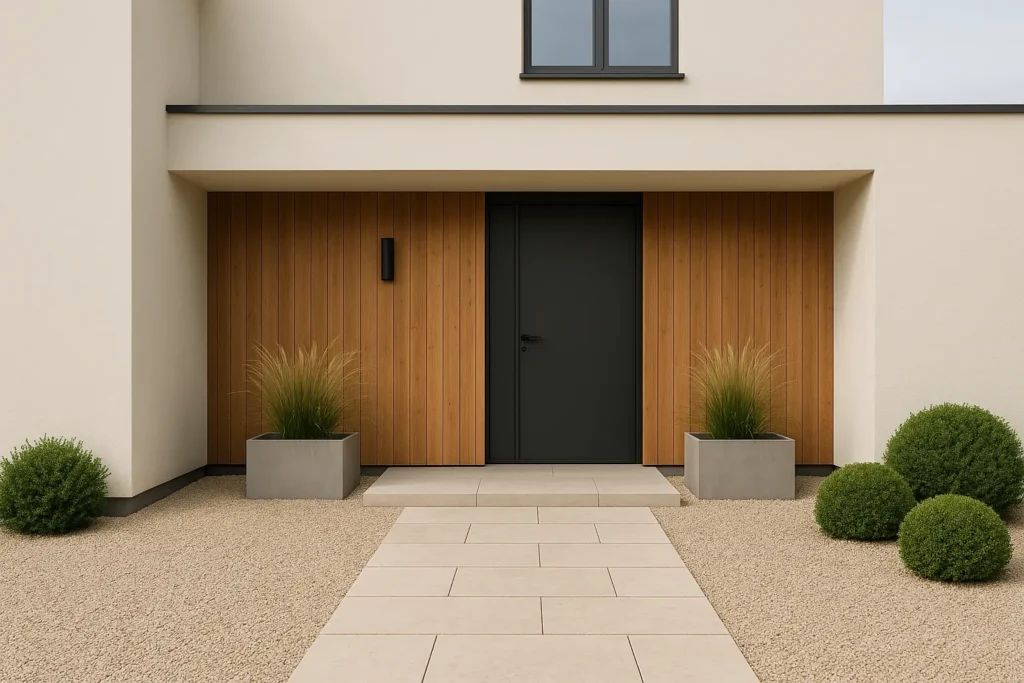
Design solutions for unusual exterior entrances
Some configurations require specific solutions. For sloping terrain, stairs with block steps create access that is both safe and aesthetically pleasing.Complete the layout with retaining walls that can become integrated planters, adding greenery to each level.
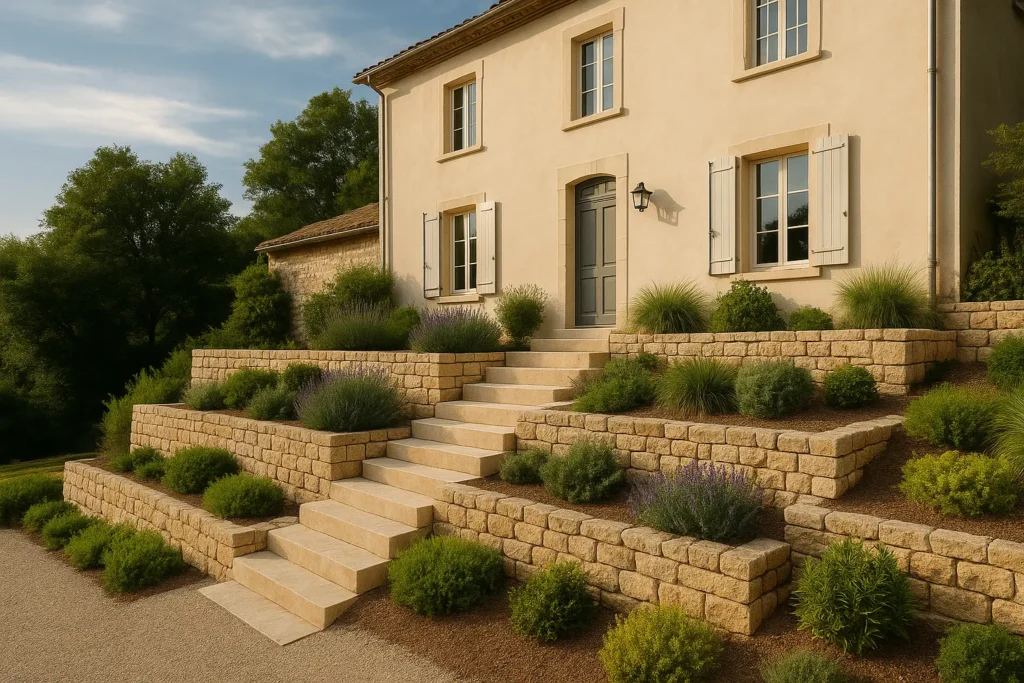
If your entryway is small, take advantage of the verticality. Use the walls to install climbing plants or hanging planters. Light colors and exterior mirrors visually enlarge the space, while multifunctional furniture like a storage bench optimizes every square centimeter.
For a open entrance Without a clear boundary, create visual structure with changes in flooring. For example, switch from gravel to paving stones to mark the threshold of the property. Large pots planted with shrubs can also elegantly define the boundaries of the space without enclosing it.
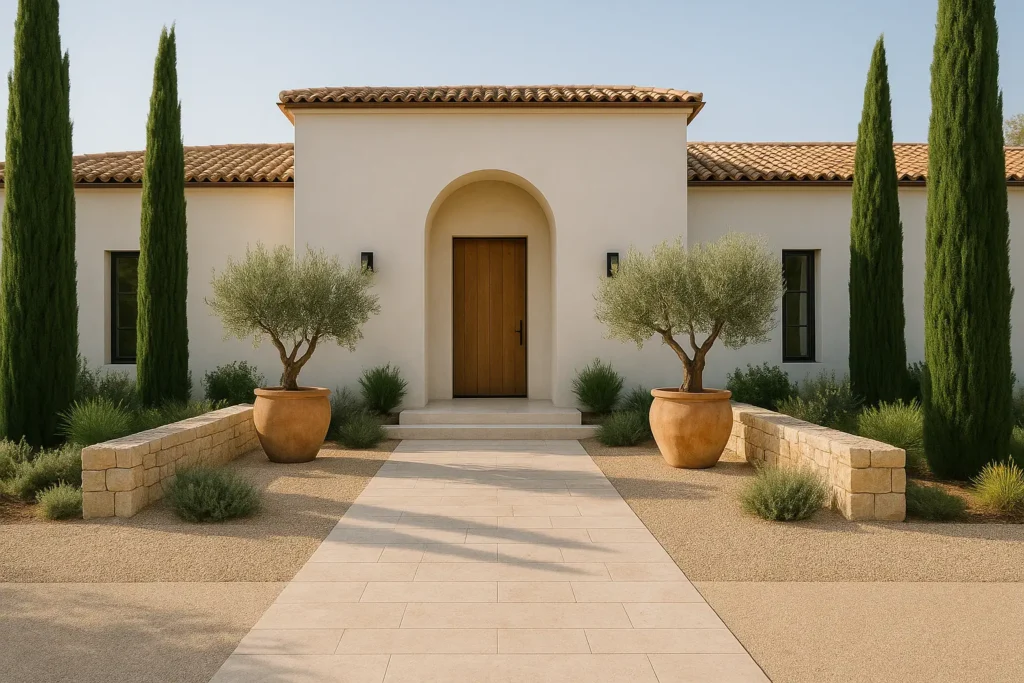
Areas exposed to prevailing winds will benefit from a windbreak hedge, while sunny entrances will require drought-resistant plants. However, avoid the fig tree whose invasive roots can damage nearby flooring and foundations.
Fences and gates: elegantly define the boundaries of your entrance
The fence and gate constitute the first boundary between public space and your private cocoon. The choice of materials reflects your style and the identity of your homeWood brings warmth and naturalness, metal offers elegance and durability, while modern composite materials combine aesthetics and ease of maintenance.
There are many styles of fencing: openwork for a welcoming and bright entrance, solid panels for greater privacy, or a green version for perfect integration into the garden. Gabions, these stone-filled mesh structures, offer a contemporary alternative that combines robustness and design..
The portal as a focal element
The gate deserves special attention, as it is often the focal point of the entrance. Whether it's swinging for traditional access or sliding to optimize space, it must harmonize with the fence and the architectural style of your home. Automation provides significant user convenience on a daily basis.
Don't forget to check local regulations that may influence the height and type of fence allowed in your neighborhood.
Decorative and architectural elements for an exterior design in front of a character house
Details make all the difference when designing an exterior entrance. A well-sized porch provides protection from the elements while creating a warm welcoming spaceSupported by columns or integrated into the facade, it becomes a striking architectural element.
Decorative walls structure the space while providing seating options. Topped with pots or lanterns, they naturally guide the viewer toward the door. A pergola can create an elegant covered walkway, especially when adorned with climbing plants.
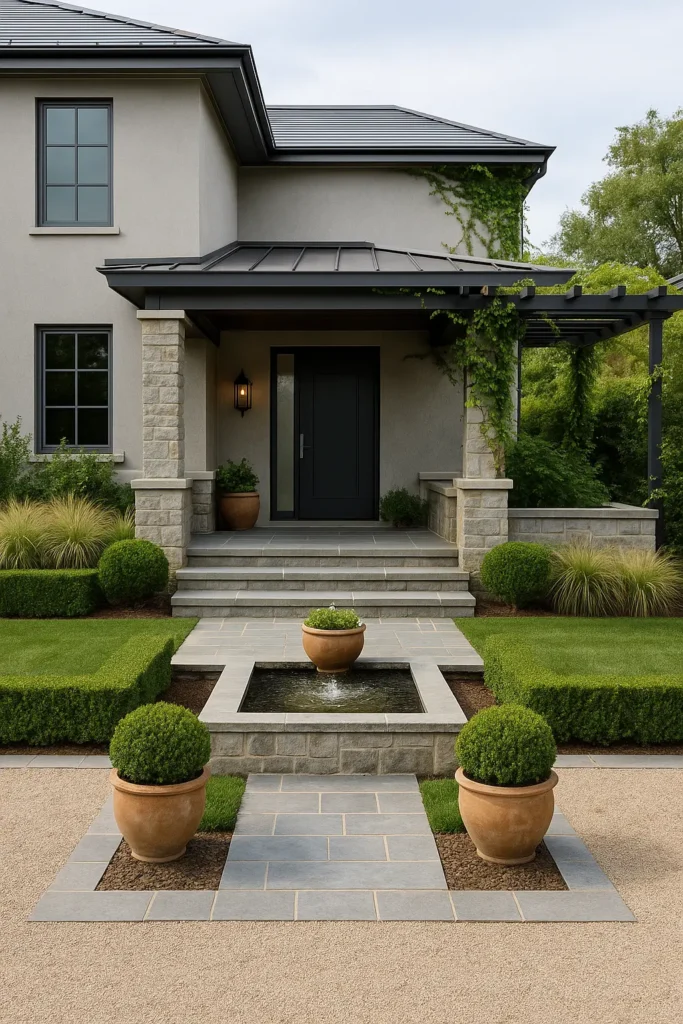
Water brings a unique sensory dimension to your entrance. A minimalist wall fountain or pond creates a calming ambiance and masks outside noise, transforming arriving at your home into a moment of decompression.
Pots and planters add a touch of greenery even to hard surfaces like a patio or paved walkway. Choose them in materials and shapes that complement the overall style of your landscaping.
Expert advice for successfully designing your exterior entrance
Before you start, carefully observe your terrain. Sun exposure, soil type and technical constraints will determine the development possibilities.Take the time to define your functional needs and your aesthetic aspirations.
Work with volumes and lines to create a balanced space. Alternate vertical elements (shrubs, columns) and horizontal elements (paths, low walls) to energize the perspective. A coherent palette of materials and colors ensures visual harmony between the different elements.
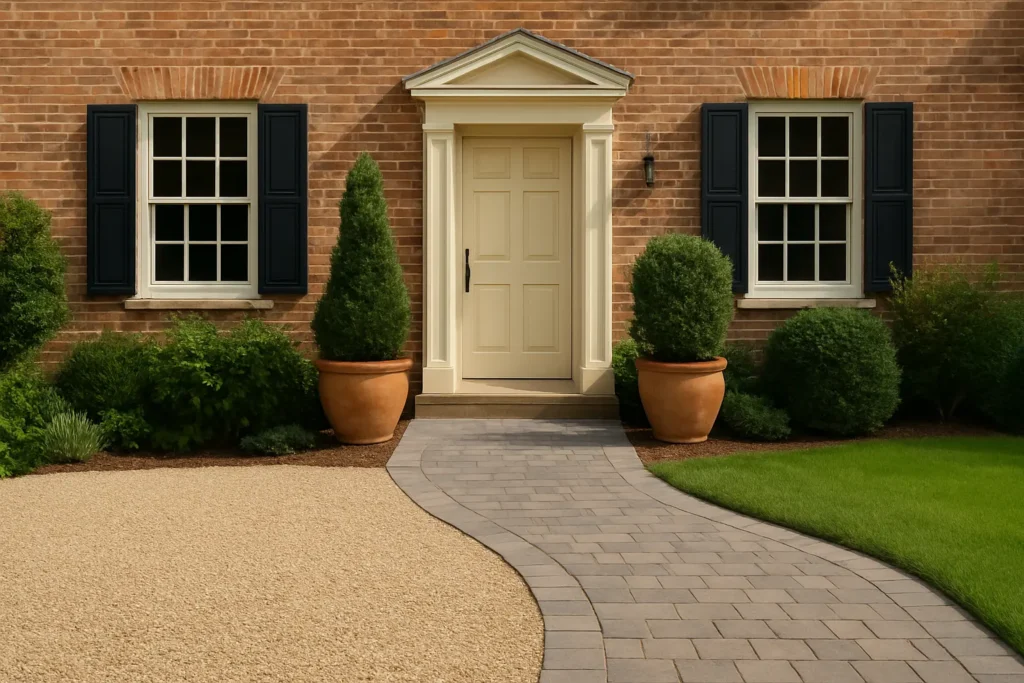
Don't forget to consider future maintenance when making your choices. Natural materials like stone or wood require more attention than their synthetic alternatives. Likewise, slow-growing plants adapted to the local climate will limit maintenance interventions while remaining aesthetic all year round.
Finally, personalize your entryway to reflect your lifestyle. Whether it's minimalist and sleek or lush and colorful, the important thing is that it reflects your personality and provides a warm welcome every time you return home.
